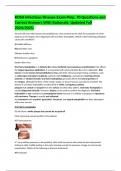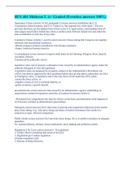ROSH Infectious Disease Exam Prep. 70 Questions and
Correct Answers With Rationale. Updated Fall
2024/2025.
50-year-old man with human immunodeficiency virus presents to the clinic for evaluation of white
plaques on his tongue. He is diagnosed with oral hairy leukoplakia. Which of the following pathogens
causes this condition?
ACandida albicans
BEpstein-Barr virus
CHerpes simplex virus
DStreptococcus pyogenes
Epstein-Barr virus
Oral hairy leukoplakia is an Epstein-Barr virus-mediated mucocutaneous manifestation that affects
the lingual squamous epithelium. It is associated with intense Epstein-Barr virus replication. Risk
factors include human immunodeficiency virus and other immunocompromising conditions, such
as solid-organ transplant recipients, patients with malignancy, and patients receiving chronic
systemic or inhaled steroids. Oral hairy leukoplakia generally affects the lateral portions of
the tongue, although the floor of the mouth, palate, or buccal mucosa may also be involved. The
lesions of oral hairy leukoplakia are described as white, corrugated, painless
plaques that cannot be scraped from the surface to which they adhere. Oral hairy leukoplakia is
usually diagnosed clinically. However, biopsy can be used to confirm the diagnosis. Oral hairy
leukoplakia is not considered a premalignant lesion because it is unlikely to progress to squamous
cell carcinoma. Therapy is usually not indicated,
but treatment with acyclovir, ganciclovir, foscarnet, and topical podophyllin has been attempted
with some success.
Oral Hairy Leukoplakia
PE will show a white plaque that cannot be scraped off
Most commonly caused by EBV in HIV patients
NOT precancerous
A 7-year-old boy presents to the pediatric clinic with his parent, who states he has had perianal
itching at night. Paddle testing in the early morning reveals the presence of eggs on microscopic
examination. Which of the following is the best treatment?
AFluconazole
,BMetronidazole
CPyrantel pamoate
DTopical permethrin
CPyrantel pamoate
Pinworms
Nocturnal pruritus ani
Diagnosis is made by tape test
Most commonly caused by ingestion of Enterobius vermicularis eggs
Treatment option includes mebendazole, albendazole, or pyrantel pamoate Dose is repeated in 2
weeks
Pinworms (enterobiasis) are the most common helminth (worm) infection in the United States and
are even more common in resource-limited countries. Enterobiasis is caused by the
helminth Enterobius vermicularis. Enterobiasis occurs most often in children between 5 and 10
years of age.
Transmission occurs due to hand contamination after perianal scratching because the eggs can
lodge beneath the fingernails. Individuals may reinfect themselves by autoinoculation from touching
their mouths or biting their fingernails. Transmission may also occur from fomites when these
objects are touched by contaminated hands. The lifecycle of the pinworm begins with ingestion of
eggs. The eggs hatch in the small intestine and release larvae. The larvae develop into adult worms
that live in the gastrointestinal tract, particularly the cecum and appendix. Gravid female worms
then migrate to the perianal skin to lay eggs onto the perianal folds. The cycle can continue as
autoinoculation occurs.
Treatment for enterobiasis consists of oral anthelmintic medications such
as mebendazole, albendazole, and pyrantel pamoate. These are taken as one dose and
then repeated in 2 weeks to ensure a high cure rate. It is important to treat the entire household to
avoid reinfection. Bedding and clothing should be washed to avoid spread from fomites.
Previous
Play
Next
Rewind 10 seconds
Move forward 10 seconds
Unmute
,0:00
/
0:15
Full screen
Brainpower
Read More
30-year-old man with a history of human immunodeficiency virus presents to the clinic with fever,
cough, and dyspnea on exertion. His last CD4 count was 100 cells per microliter. Chest X-ray shows
bilateral diffuse interstitial infiltrates. Polymerase chain reaction of respiratory fluids obtained by
bronchoalveolar lavage confirms the diagnosis of Pneumocystis jirovecii pneumonia. Which of the
following is the recommended antimicrobial treatment?
AAerosolized pentamidine
BDapsone
CFluconazole
DTrimethoprim-sulfamethoxazole
Trimethoprim-sulfamethoxazole
Pneumocystis Pneumonia (PCP)
Caused by the fungus Pneumocystis jirovecii
Risk factors: HIV, immunocompromised host, or immunosuppression
Sx: gradual onset of dyspnea, nonproductive cough, fever
Labs: ABG, CD4 < 200/mm3, increased LDH
CXR: diffuse bilateral ground-glass opacities (batwing pattern), if CXR is nondiagnostic obtain CT
Dx: confirm with staining or PCR of respiratory specimens (induced sputum or BAL)
Tx: TMP-SMX, add corticosteroids for moderate to severe disease (air PaO2 < 70 mm Hg or A-a
gradient ≥ 35 mm Hg)
Comments: can present with pneumothorax
Clinical manifestations of _____ include fever, abdominal pain, nausea, vomiting, diarrhea, myalgias,
and anemia. Diagnosis is made by observing parasites on a peripheral blood smear.
Malaria
Which of the following is a risk factor for Cryptosporidium infection?
AHuman immunodeficiency virus infection with a CD4 count of 150 cells per microliter
BKidney disease
CLiver disease
, DTuberculosis infection
AHuman immunodeficiency virus infection with a CD4 count of 150 cells per microliter
Cryptosporidium is an intracellular protozoan that is one of the most common parasitic enteric
pathogens in humans. It has been associated with gastrointestinal disease in sporadic self-limited
outbreaks among immunocompetent hosts and chronic illness in immunosuppressed patients.
Cryptosporidiosis is associated with a secretory diarrhea that can present with malabsorption
Transmission of cryptosporidiosis can occur directly by the fecal-oral route from an infected person
or animal or from a fecally contaminated environment, such as a food or water source. Risk factors
include residence in or travel to a resource-limited country, known exposure to water
contaminated with Cryptosporidium, immunocompromised status, and age of 1 to 9 years of age.
The incubation period is usually 7 to 10 days. The diagnosis of cryptosporidiosis is generally made
by microscopic identification of the oocysts, polymerase chain reaction testing, or enzyme
immunoassays
Most patients with cryptosporidiosis have mild to moderate symptoms and can keep up with their
fluid losses without the need for intravenous fluids or other additional therapies. However, for
patients with severe and prolonged symptoms, antidiarrheal agents (e.g., loperamide) are often
used. Patients with severe volume loss may also need oral or intravenous repletion of
electrolytes. Nitazoxanide is used in patients with severe or persistent (more than 2
weeks) symptoms. Paromomycin is an alternative antimicrobial if nitazoxanide is not available.
Patients with Cryptosporidium infection who are immunocompromised may also need therapy
to restore immune function.
How is Epstein-Barr virus mononucleosis distinguished clinically from cytomegalovirus
mononucleosis?
Answer: Tonsillitis, enlarged cervical lymph nodes, and splenomegaly are more common in Epstein-
Barr virus mononucleosis.
Fever and systemic symptoms are more common in cytomegalovirus mononucleosis.
A 45-year-old man with a history of renal transplantation presents to the emergency department
with fever, headache, and confusion. Lumbar puncture for cerebrospinal fluid analysis is performed
for suspected meningitis. Which of the following diagnostic tests would be best to confirm the
diagnosis of cytomegalovirus?
AComplete blood count with differential
BPolymerase chain reaction
CShell vial viral culture
DTraditional viral culture





